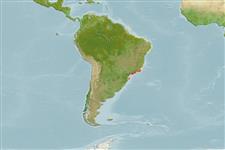رده بندی / Names
اسامي عام | مترادف | Catalog of Fishes(جنس, گونه ها) | ITIS | CoL | WoRMS | Cloffa
>
Blenniiformes (Blennies) >
Labrisomidae (Labrisomids)
Etymology: Paraclinus: Greek, para = the side of + Greek, klinein, kline = sloping and bed, due to the four apophyses of sphenoid bone (Ref. 45335); spectator: From its habit of observing divers and its surroundings..
Environment: milieu / climate zone / depth range / distribution range
بوم شناسي
دريايي وابسته به آب سنگ; تغييرات عمق 1 - 7 m (Ref. 43114). Tropical
Southwest Atlantic: Brazil.
Size / Weight / سن
Maturity: Lm ? range ? - ? cm
Max length : 5.2 cm SL جنس نر / بدون خواص جنسي; (Ref. 43114)
خارهاي باله پشتي (کل): 27 - 29; خارهاي باله مخرجي 2; شعاع نرم باله مخرجي: 18 - 20; مهره ها: 34. Body elongated, mean body depth 21.7% SL in adult males. Wide predorsal area, mean 22.6% SL in adult males. First 2 dorsal fin spines much longer than the rest; distance between 3rd and 4th spine greater than orbit diameter; last dorsal fin element segmented. Opercular spine flattened and triangular (Ref. 43114).
Prefers shallow rocky reefs. Smallest ripe female at 3.7 cm SL (Ref. 43114).
Life cycle and mating behavior
بلوغ | تولید مثل | تخم ریزی | تخم ها | Fecundity | توزاد ( لارو)
Guimarães, R.Z.P. and A.C.L.H. de Bacellar, 2002. Review of the Brazilian species of Paraclinus (Teleostei: Labrisomidae), with descriptions of two new species and revalidation of Paraclinus rubicundus (Starks). Copeia 2002(2):419-427. (Ref. 43114)
وضعيت در فهرست قرمز IUCN (Ref. 130435)
خطر برای انسان ها
Harmless
استفاده انسانی
اطلاعات بيشتر
اسامي عاممترادفسوخت و سازشکارچیانسم شناسي بوم زيستيتولید مثلبلوغتخم ریزیSpawning aggregationFecundityتخم هانمو تخم
مراجعآبزي پرورينمايه آبزي پرورينژادهاژنتيكElectrophoresesوارثبيماري هافرآوریNutrientsMass conversion
همكارانعکس هاStamps, Coins Misc.صداهاسيگواتراسرعتنوع شناگریمنطقه آبششيOtolithsمغزهابینایی
ابزارها
گزارش های ويژه
بارگيری XML
منابع اينترنتي
Estimates based on models
Preferred temperature (Ref.
123201): 22.5 - 27.7, mean 26.7 °C (based on 94 cells).
Phylogenetic diversity index (Ref.
82804): PD
50 = 0.5000 [Uniqueness, from 0.5 = low to 2.0 = high].
Bayesian length-weight: a=0.00912 (0.00399 - 0.02083), b=3.06 (2.87 - 3.25), in cm total length, based on LWR estimates for this (Sub)family-body shape (Ref.
93245).
Trophic level (Ref.
69278): 3.5 ±0.4 se; based on size and trophs of closest relatives
Fishing Vulnerability (Ref.
59153): Low vulnerability (10 of 100).
